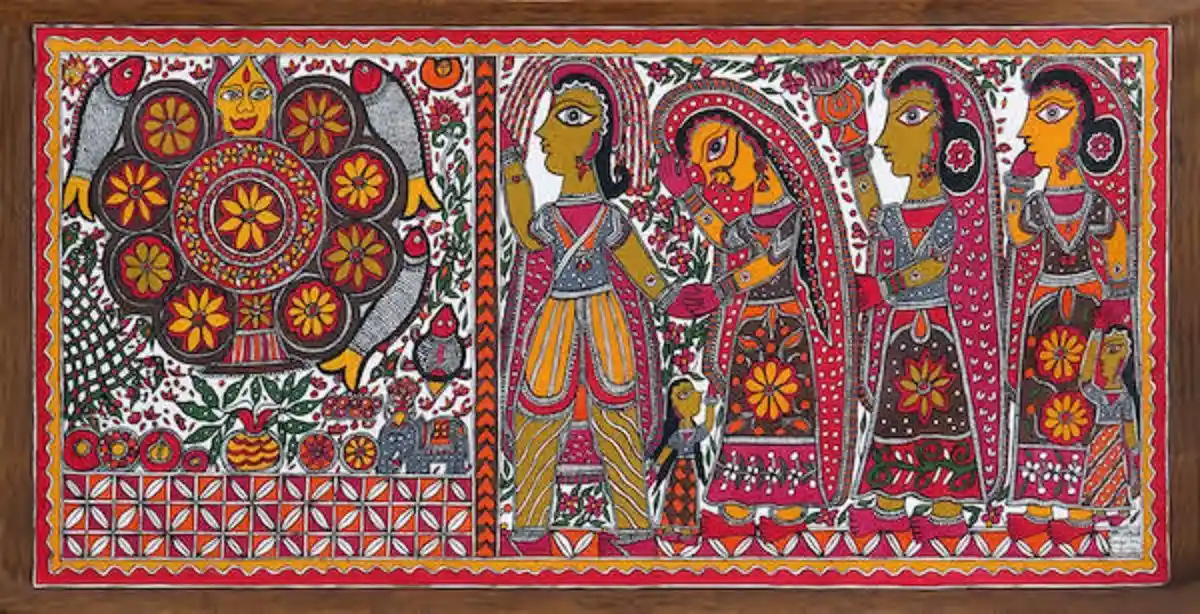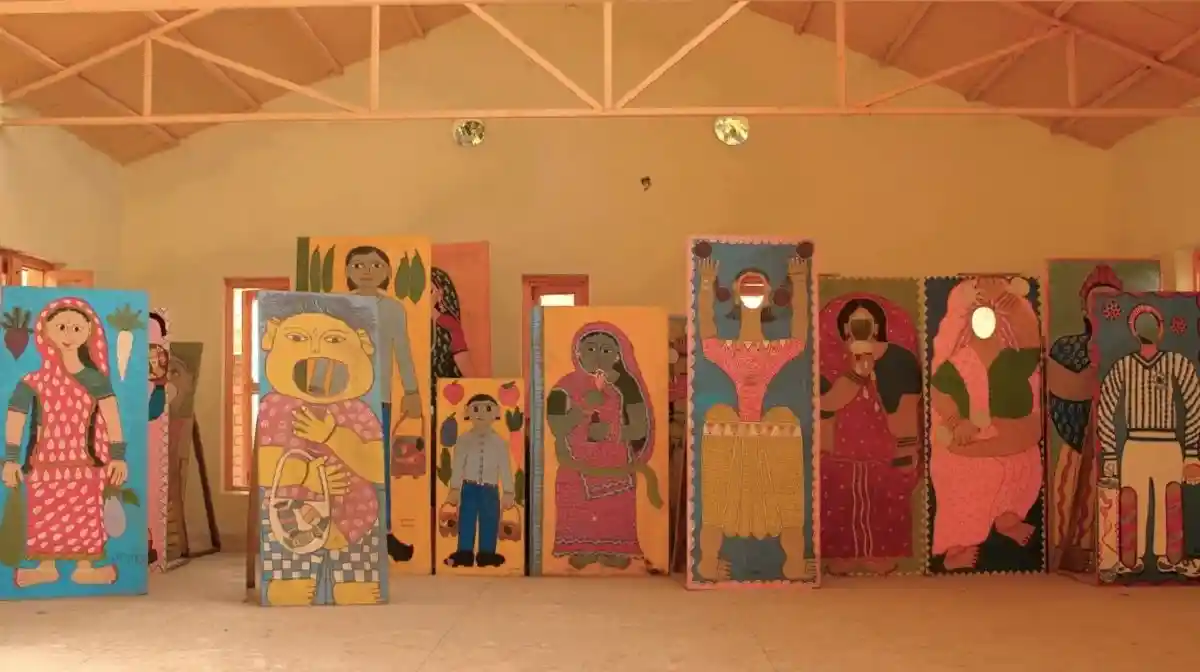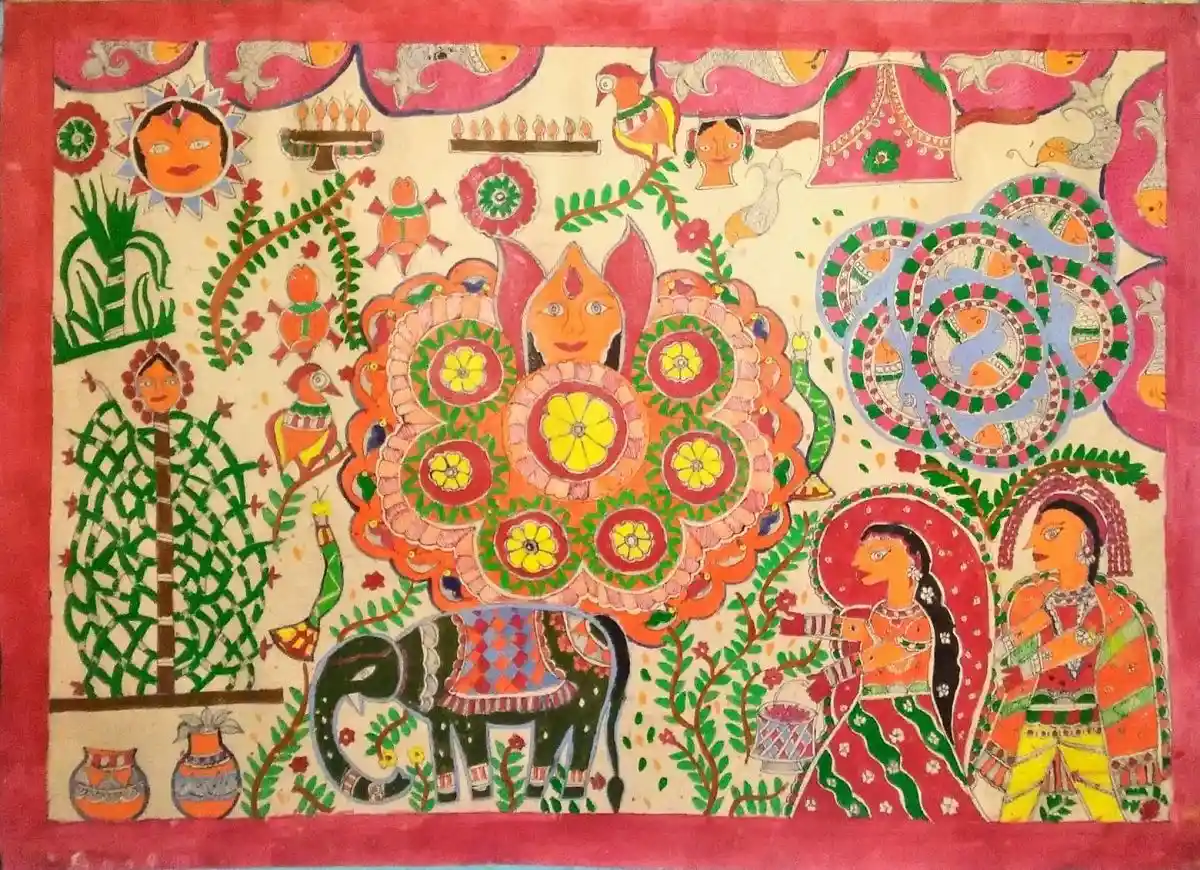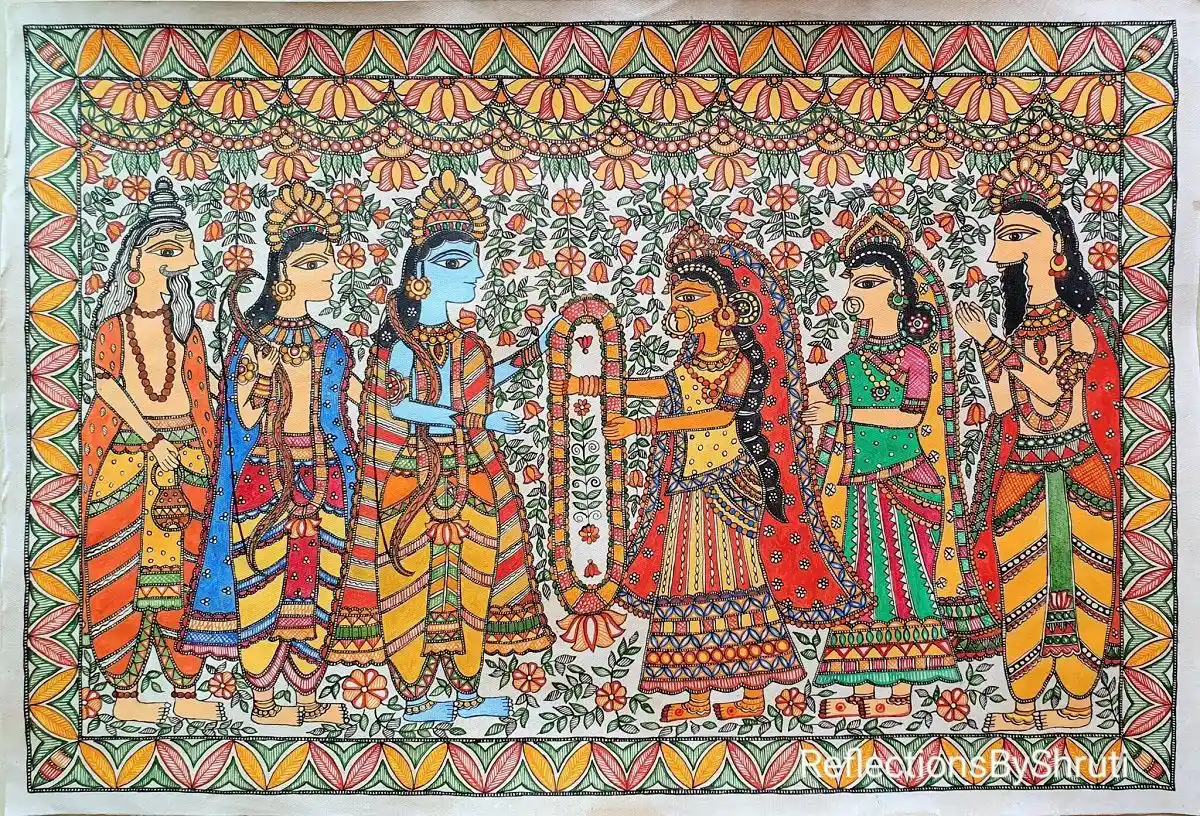Madhubani Art: An Art Beyond Ethnicity
The taste of connoisseur, the art has hues of softer and harmonized colors. With pink, blues and yellows in beautiful contrast, they have a unique touch of nature and artistic strokes of many famous artisans. Beautiful motifs that brings bright eyes and figurines to highlight, the materials for Madhubani keep on changing, but the techniques remain the same.

‘Preserving ethnic art forms is the key’; Image Source: Wikimedia Commons
Early in the morning, I heard a soft tap on my door. Keeping my brushes aside, I checked myself in the mirror. There were traces of paint on my cheeks and chin. Wiping it hastily, I ran down the stairs. As I opened the door, two hands wrapped around me. "Woah! You're choking me." "Oops! I am so sorry. By the way, what were you doing?" asked Raina, wiggling her eyebrows funnily. "Nothing much. I was completing the assignment for Mr. Ferrero. But just then, he called me up and asked me to make something more traditional that would bring some contrast in his ultra-modern house. Now I am confused", I said with a sad voice.
"Well, you live in India- a land full of art and colour. In fact, traditional art forms are considered one of the greatest assets of the Indian subcontinent. While some are old and authentic, others are an amalgamation of time-honored art forms with a twist of modernism.", said Raina with an excited voice.
"I know. But how do you think I can identify all of these art forms?" I asked with a confused expression. Raina's eyes twinkled with the idea that I knew was uncertain. Then came out the words from her mouth, "Let's plan a trip to different states of India, and then we can figure out the art forms you would like to do.", she said with an excited voice. "But you know that I don't like to travel. Also, how do you plan on visiting different states without having prepared for a proper plan?" I asked with raised eyebrows.
"Let's go upstairs and discuss this. I have planned the entire trip. You'll need to accompany me.", she said with a wink. It's 31st March, and we are here, standing in the Chhatrapati Shivaji Maharaj International Airport queue, all ready to board the flight to Bihar. The first destination on our travel list in Bihar, the centre of power, learning, and culture. I didn't know what awaited me there, but I knew one thing for sure the state would surely welcome me with open arms.
Today is 2nd March, and indeed, Bihar is a great state, and its people are pretty welcoming. Raina stopped a rickshaw puller and asked to take us to Darbhanga. As I stepped inside the rickshaw, I was in awe of the interiors. Shades of blue, orange, red, green, yellow, and many others combined to form beautiful patterns and scenes from Mahabharata and Ramayana. The paintings had a unique style. Every detail was vivid, and there were no gaps in the image.
"Bhaiya, these paintings are beautiful. Who made these?" I asked. "Madamji, this is Madhubani painting. Bihar is famous for this form of painting. My wife has painted this rickshaw. She has been learning this art form from Sita Devi for quite a long time.", the rickshaw puller said.
"Could you take us to that place where this art form was originated? We would like to know more about it.", said Raina in an excited voice. "Sure, madam Ji. I will take you to Mithila, where the Madhubani art form has been practiced to date. We also have a special academy dedicated to this art form. People from all over the world come to this academy to learn Madhubani painting.", the rickshaw puller said.
As we reached Mithila, I could see almost every house decked with beautiful Madhubani patterns. The mud houses highlighted the vibrant colours, and the patterns popped out to please the eyes. On our way to the academy, we saw numerous places where women were sitting on the porch and were busy making patterns on different backgrounds. "This is Rani Jha's house. She teaches these women the art of making Madhubani paintings. I think she might have answers to all your questions." said the rickshaw puller, with a subtle smile on his face.
An hour later, we were sitting on a cane cot, with tea-filled kulhads in our hands. "How did this art form originate?" I asked. "Catchy geometric patterns and religious motifs, Madhubani paintings are sloshed in myths and antiquities. The roots of Madhubani go back to when Ramayana came into the scene. After Sita decided to marry Ram, King Janaka wanted to ensure that all the preparations were done with great detail. He gave the most important responsibility of decorating the houses to the kingdom's women.
Janak also permitted them to choose the theme for painting the houses. When the kingdom's women decided to introduce a theme combining fertility, creation of life, a celebration of nature, and worship of God, these themes gave birth to Madhubani painting. Since then, it has become an integral part of women who are considered at the lowest rung of society. This art form is like a liberation for these women who want to get free from the clutches of the society.", said Rani, with a subtle smile.
"Since this art form is more than 2500 years old, how did this exist for so long?" asked Raina. "Now Madhubani is quite famous. But this was not the situation half a century back. India has its own set of natural disasters to deal with, and these calamities are one of the major causes of destruction. They change not only the socio-political and cultural landscape of the country but also the human mindset. Back in the year 1934, an earthquake shook the land of Mithila, and most of the villages of Bihar were destroyed. After the quake, W. G. Archer visited these villages with his entire team to plan the reconstruction project. Here, he found some colourful remains of Madhubani painting on the dilapidated walls. He believed that these paintings were at par with the works of the modern artists of Western countries.
He took the photos of these dilapidated walls that still glistened with beautiful patterns and published an extensive article about it on the Marg, a journal of art and culture of India. This article highlighted the almost extinct art form of Madhubani and inspired the new generation of artists to practice this art form. Exactly after thirty years, Mithila again faced a drought-like situation. The then director of All India Handicrafts Board, Dr. Pupul Jayakar, advised the women of Mithila to revive the Madhubani art form and experiment on various surfaces like canvas, fabric, paper, wall, and board.", said Meena, yet another teacher at the National Institute of Mithila Art.
"Do you know girls that Madhubani painting is not limited to any one style? Different hands work differently, thus giving rise to five different styles of paintings. The most famous type is Bharni, which means 'filling' in Hindi. This artwork is mainly dedicated to the deities and Hindu mythology. Though we see a lot of colours in the Madhubani paintings, there is one monochrome form. This style is called Katchni and is mainly used to portray animals, birds, flowers, and other beautiful creations of nature.
The famous Madhubani artist Chanu Devi started yet another style called Godna. While making this, one has to use a pen made up of bamboo, and kajal should be used as the ink. The fourth style of painting is Tantrik. This style is sporadic and can be seen only during festivals or special occasions as it represents India's traditional and religious past in its truest sense.
Indeed, Madhubani is quite fascinating. The big curious eyes in the paintings twinkled brightly and stared curiously at me. The vivid colours popped out of the walls and asked me if I could do justice to this art form. I don't know if I could match the brilliance of these artists, but I know one thing for sure Mr. Ferrero would indeed have these paintings in his living room to contrast with his ultra-modern home.
Last but not least, the Kohbar style is considered one of the most famous art forms made during Indian weddings. An entire room is painted with fertility images and is decorated as a nuptial chamber. The groom and the bride are made to stay in this chamber for three days, and on the fourth day, they are expected to consummate their marriage.", completed a middle-aged woman, while giving examples on a beautifully painted board.
"How is Madhubani art different from other traditional art forms?" I asked with a curious expression. "For starters, Madhubani art figures are usually two-dimensional. Sharp noses, geometrical faces, and bulging eyes are some of the unique characteristics of these paintings. The borders of these figures are drawn with double lines. Most of the paintings are filled with natural things like flora and fauna. Most of the paintings have no spaces in between and detailed with intricate patterns.", said Rani.
"Not only India but Nepal too is involved in making Madhubani paintings. Both the countries lie in flatlands and are blanketed by sugarcane fields and green meadows. Though divided by borders, both the countries are united by cultures, history, and of course, Madhubani painting. Most Madhubani artists sell their artworks to tourists and in craft shops. Most of these artists have received worldwide recognition in numerous galleries and museums across countries like South Asia, Europe, United States, and Japan.", said Meena.

When Mithila art reached Nepal; Image Source: Nepali Times

Kohbar: An art of nuptial relationship; Image Source: International Indian Folk Art Gallery

Ram Sita Vivah scene as depicted in Madhubani painting; Image Source: International India Folk Art Gallery


